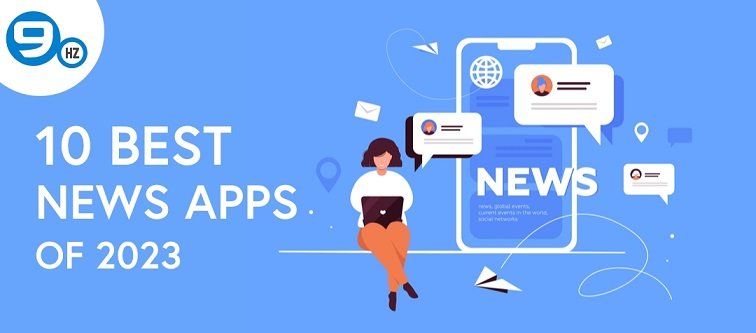
10 Most Useful News 2023
It’s no secret that the world is changing quickly. The technology industry is booming, and so are the ways we get information. With so many sources of news available, it can be hard to decide which sources are trustworthy. To help you make informed decisions, we’ve compiled a list of the top 10 most useful news sources for 2023. These sources will give you comprehensive coverage of major events and trends, allowing you to stay up-to-date on all the latest happenings. So whether you’re looking to stay in the know about current events or prepare for what’s coming next, these sources will have you well-informed.
News is one of the most important aspects of our lives. Whether we’re paying attention to the latest political developments or keeping up with sports scores, news is a vital part of our day-to-day lives. But with so much information available online, it can be hard to determine what’s worth reading and what’s not. In this blog post, we will help you determine which news stories are most relevant for your current situation, and how to get the most out of them.
The state of the economy
The economy is slowly recovering but critics are concerned that the new administration will neglect economic reform. Currently, the unemployment rate is at 4.9 percent and wage growth has been minimal. Trump has promised to stimulate the economy with large infrastructure projects and tax cuts, but he faces significant opposition from Congressional Democrats who argue for increased spending on social programs instead. In early 2018, Trump proposed a $1 trillion dollar deficit in the budget for fiscal year 2019, which caused alarm among some Republicans. Despite these dissenting voices, it remains to be seen whether or not Trump’s policies will have a substantive impact on the US economy.
The economy has been improving gradually since the Great Recession of 2008-2009, but it remains fragile. Growth in 2016 was 3.2%, which is below the 4% average for the past several decades. The unemployment rate is low, but there are still many jobs that are not available to people who want them. Inflation is low, but it could rise if the Federal Reserve increases interest rates. There have been some signs of improvement in the labor market, but wages have not increased very much and there are a lot of people who are unemployed or underemployed. There has been a lot of talk about how to create more jobs, and there have been a number of proposals made to improve the economy.
The 2020 Presidential Election
The 2020 Presidential Election is around the corner, and with it comes a lot of speculation and excitement. Who will be running in this year’s election? Who are some of the front runners? Here are five facts about the 2020 presidential election that you may not know.
1. The 2020 Presidential Election will be the first time that voters in all 50 states will have the opportunity to cast ballots for president. Previously, only those living in a state which had chosen to participate in the electoral process were allowed to vote for president. This change was made as part of the Voting Rights Act of 1965, which aimed to ensure that all citizens could have their voice heard when it came to elections.
2. There are currently no announced candidates for the 2020 Presidential Election. However, a number of individuals have been tipped as potential contenders, including Former Vice President Joe Biden, Former Secretary of State Hillary Clinton, Senator Bernie Sanders (I-VT), and Governor Andrew Cuomo (D-NY).
3. The race for the Democratic nomination is far from decided, and there is still plenty of time for other candidates to enter the fray. If no candidate secures an outright majority at the party’s convention in July, then a runoff election will take place between two leading candidates – likely either Biden or Sanders.
4. Although no candidate has yet been officially announced, polls suggest that Clinton is by far the most likely contender to win the election – Write For Us.
The opioid epidemic
The opioid epidemic is a serious public health problem, with an estimated death toll of 180,000 in the United States between 1999 and 2017. The epidemic began with the widespread use of prescription opioids, but has since evolved into a situation where illicit opioids are now the primary driver of overdose deaths.
Heroin is the most common type of opioid used in America, and it is responsible for more than half the overdose deaths. Other opioids, including fentanyl and carfentanil, are also involved in a significant number of overdose deaths. In 2016, there were more than 28,000 deaths due to opioid overdoses.
There are many factors contributing to the opioid epidemic, including over-prescribing of opioids by doctors, addiction to opioids caused by chronic pain conditions that have not been treated adequately, and illegal distribution networks that sell high- potency opioids on the black market. efforts to address the opioid epidemic will require cooperation from a variety of stakeholders – from medical professionals to law enforcement officials – who must work together to create safe environments for patients and prevent further addiction
How fake news is changing the way we live our lives
Fake news has been around for years, but it’s only recently that people have become more aware of the issue. It started with political scandals, like the election of Donald Trump in America, and then progressed to stories about celebrities and other public figures.
Nowadays, fake news can be found on any topic. It can be articles reporting false information about events that have actually happened, or it can be stories that are completely made up.
The way that fake news is changing the way we live our lives is twofold. First of all, it’s creating a lot of fear and uncertainty in our society. Second of all, it’s affecting how we make decisions about important matters.
As a result of all this fake news, a lot of people are now sceptical about anything they read online. This means that they’re less likely to trust information that comes from traditional sources, like newspapers or television networks.
This has serious implications for society as a whole because it means that we’re not getting accurate information about important events. For example, if we want to know what’s happening in Syria, we’re not going to get an accurate picture from the mainstream media because a lot of them are fake news outlets themselves.
Instead, we’re going to have to rely on independent sources which may not always be reliable either. This is why fake news is such a problem – it’s changing the way we live our lives without us even realizing it!
The rise of virtual reality
Virtual reality (VR) is a technology that allows users to experience a three-dimensional environment, often through the use of head-mounted devices. VR has been growing in popularity in recent years, with many companies investing in creating innovative VR headsets. The potential benefits of VR include increased immersion and an ability to explore new worlds. However, some challenges must be addressed before VR can become mainstream.
One major challenge is that most people are not used to wearing bulky headsets all the time. Another is that the latency time between the user’s motion and the display makes it difficult to interact with virtual objects. Finally, there is no single market for VR headsets, so developers must create different versions for different platforms, which can be difficult and expensive. Despite these challenges, VR is having a noticeable impact on various industries, including gaming, education, and tourism.
How climate change is affecting the world
Climate change is a global problem and it’s affecting every country in different ways. Some countries are more affected than others, but all of them are feeling the effects of climate change.
The warmer temperatures that we’re experiencing right now are just the beginning. In the future, we’ll see more extreme weather events, like record-breaking heat waves, heavy rainfall, and powerful storms.
This isn’t just a problem for places like Europe or North America – it’s happening all over the world. In some parts of the world, climate change is making it harder to grow food or water resources. And in other parts of the world, it’s causing damage to infrastructure and communities.
Climate change isn’t going to stop anytime soon, so we need to start taking action right now. We can make a difference by reducing our own carbon footprints and helping to fund cleaner energy projects around the world.
How technology is impacting education
1. Technology is impacting education in a variety of ways, with some more pronounced than others.
2. Email has revolutionized communication between students and teachers, making it easier for both sides to stay in touch.
3. Mobile apps have become essential tools in the classroom, allowing educators to keep track of students’ progress and adjust curriculums as needed.
4. Online learning platforms allow students to access courses from anywhere in the world, making learning more accessible and flexible than ever before.
5. New technologies are constantly being developed that could further impact education, including virtual reality and augmented reality. As these technologies evolve, they may play an even larger role in how we learn and teach in the future.
How artificial intelligence is changing everything
Artificial intelligence (AI) has been around for decades, but the recent development of deep learning has made AI more powerful and ubiquitous than ever before. Here are five ways AI is changing everything:
1. Artificial intelligence is changing the way we search for information.
Thanks to machine learning and artificial intelligence, computers can now learn how to interpret and analyze data on their own, which makes it easier for humans to find what they’re looking for. This technology has already led to major advances in search engines like Google and Yahoo, as well as in other areas like health care and business analytics.
2. AI is changing the way we shop.
AI can help us identify relevant products and prices quickly and efficiently, making shopping easier and more efficient than ever before. This technology is being used by online retailers like Amazon and Walmart, as well as by brick-and-mortar stores like Macy’s and J.C Penney.
3. AI is changing the way we work.
AI can help us automate tasks that would be difficult or time-consuming to do manually – something that’s particularly important in fields like manufacturing and logistics where accuracy is paramount. This technology is being used by companies like Volkswagen AG, Toyota Motor Corporation, General Motors Corporation, and ABB Ltd., among others.
4. AI is changing the way we educate ourselves .
AI can help us learn new subjects faster and more effectively than ever before – something that
And finally, the future of food
The future of food is looking bright, thanks to advances in technology. The internet of things will help us to understand and track the health of our crops from seed to table, and drones will allow us to manage our crops more efficiently. We’re also developing new techniques for growing food in difficult environments, like undersea or on desert islands. There are endless possibilities for the future of food, and we’re juststarting to scratch the surface.
1. With advancements in technology, the future of food is looking bright.
2. Scientists are working on ways to create crops that can withstand harsh climates and conditions, as well as produce more food with less water and fewer inputs.
3. Additionally, new methods of production are allowing for more diverse and flavorful foods, from fruits and vegetables to meat products.

